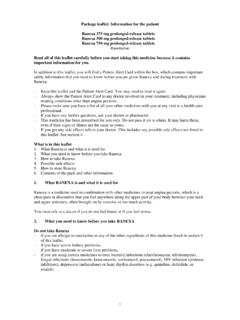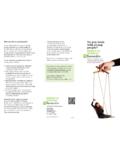Transcription of HSE information sheet
1 hse information sheet Solvents Construction information sheet No 27 (revision 2) Introduction Solvents are chemical substances. In construction products they act as carriers for surface coatings such as paints, varnishes, adhesives and pesticides. The most common solvents found in construction are: white spirit - in paints, varnishes and cleaning products; xylene - in paints, adhesives and pesticides; 1-butanol - in natural and synthetic resins, paints and lacquers. Many construction products contain mixtures of solvents. Exposure to solvents can have serious effects on workers health. If you use solvents or manage or supervise someone who does, or if you are involved in the specification of solvent-based products for use in construction, you need to be aware that: exposure can be a health hazard; and safe working practices must be used to minimise the risk of exposure.
2 This sheet advises on how to use solvents safely. Health effects Solvents can make you ill by: breathing in vapours - paints, paint strippers and glues give off solvent vapours as they dry or cure and these vapours may be harmful. Deliberate inhalation of solvent vapours (glue sniffing) can kill; skin contact - some solvents can be absorbed through the skin. Repeated or prolonged skin contact with liquid solvents may cause dermatitis; eye contact - contact with liquid solvent and solvent vapour can cause irritation and inflammation; ingestion - solvents can be taken into the body on contaminated food, drink and cigarettes.
3 People have accidentally drunk solvents that have been kept in old, unlabelled drinks containers. The main effects of solvents are irritation of the skin, eyes and lungs, headache, nausea, dizziness and light headedness. Exposure can impair co-ordination and this can make people more prone to accidents such as falling off ladders. People may lose concentration on important or difficult tasks and they may react more slowly to dangerous situations. The effect can vary from person to person and will generally be made worse by drinking alcohol. Very high exposures can cause unconsciousness and even death, for instance where adhesives are used in unventilated confined spaces or where there are serious spillages.
4 Other possible effects on health vary according to which solvent people are exposed to. Anyone who has been exposed to solvents and feels that their health has been affected should seek medical advice. Legal provisions Work with solvent-based construction products is subject to the Control of Substances Hazardous to Health Regulations 2002 (COSHH), which require the health risk to be assessed and then prevented or controlled. Users will find information on the hazards on the containers but they should also get information (often as Hazard Data Sheets ) from manufacturers and suppliers. Users then need to consider how those hazards can be prevented or controlled.
5 Designers or people who specify products for use in construction have a duty under regulation 13 of the Construction (Design and Management) Regulations (CDM) to avoid risks to the health and safety of those carrying out construction work. Where it is not possible to avoid the risk, they should specify the least hazardous products which perform to an acceptable standard. If solvent-based products cannot be avoided, the designer or specifier should provide information about safe use. Precautions Preventing exposure First of all, consider whether the solvent-based products need to be used at all. Can they be replaced by an alternative, less hazardous material?
6 For example, use a water-based formulation if possible; these are widely available. Controlling exposure If solvent-based products are used, make sure the work area is well ventilated. Open doors, windows, roof lights etc to increase ventilation and make sure that they are kept open. Local exhaust (mechanical) ventilation may be necessary in some cases. If possible, avoid spraying solvent-based products, as this causes more vapour to get into the air than using a brush. Store solvents in properly labelled, suitable containers. Use dispensers where possible to keep evaporation to a minimum and reduce spillage. Keep lids on containers unless contents are being poured or dipped etc.
7 Use sealed containers for solvent waste. Dispose of solvent-soaked rags in closed containers. Train workers in how to minimise exposure and in how to deal with spillages. Spillages Spillages can lead to very high exposures and greatly increased fire risk. The risks from spillages and the precautions needed to deal with them should be considered in a risk assessment before the work starts. Fire Many solvents are flammable. Take precautions to avoid fire and explosion risks; in particular, do not smoke in areas where solvents are used. Store products containing solvents in a secure and well ventilated area. Personal protective equipment (PPE) If exposure cannot be adequately controlled in any other way, workers should wear PPE.
8 They may need to wear one or more of the following: protective overalls; appropriate gloves that have been specially selected for use with solvents; face shields; respiratory protective equipment, where ventilation does not provide adequate control. Half-mask respirators fitted with the appropriate filter may be sufficient in many instances, but compressed airline breathing apparatus may be necessary where solvents are sprayed, or when working in a confined space. Those who need to wear PPE should be trained in its proper use and in its limitations. Store the equipment in clean, dry conditions away from chemicals - a locker would be suitable.
9 PPE should be maintained and kept clean and fit for wear. Hygiene Good personal hygiene is very important. Facilities for washing and changing should be provided and workers should wash their hands before eating, drinking, smoking and going to the toilet. Eating, drinking and smoking should take place away from the work area. You should not smoke in areas where solvents are used -solvents passing through a cigarette can break downinto even more harmful substances. Articles which become heavily contaminated with solvent should be removed immediately. Overalls and contaminated personal clothing should be laundered before being reworn.
10 It may be necessary to air them in a safe place first, to let the solvent evaporate off. Laundering should only be done by professional cleaners who have been told of the nature of the contamination. Thinners should not be used to remove paint or grease from the skin, as this can cause the skin to become dry and inflamed. Proper cleaning materials, eg soap or other cleanser, should be provided and used. First aid Anyone who appears to have been affected by solvents should be taken into the fresh air immediately and given appropriate first-aid treatment. Heavily contaminated clothing should be removed as soon as possible.
















